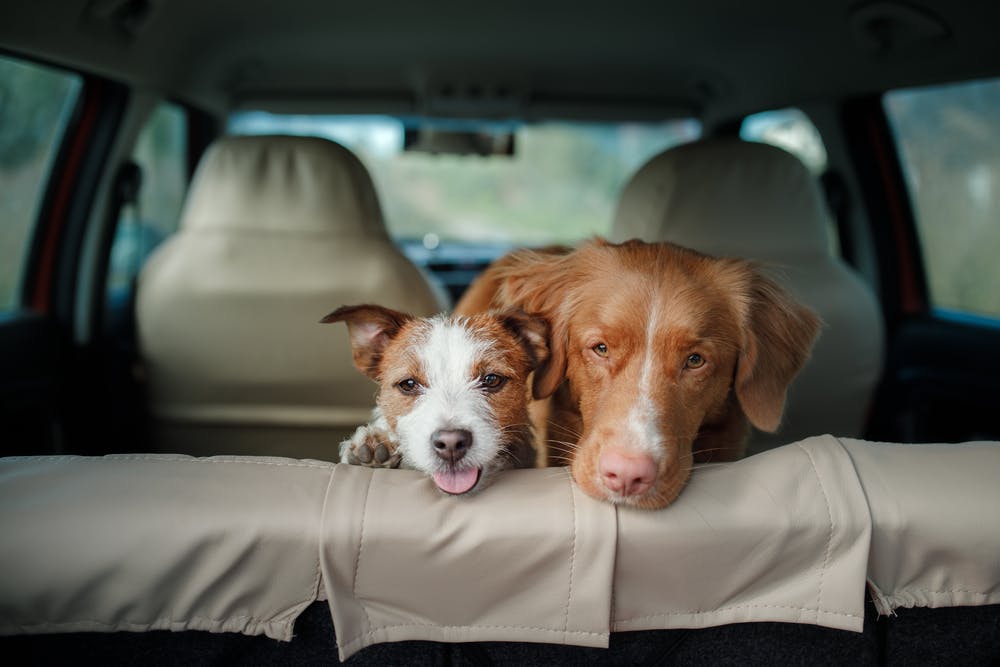
Written by Grace Park
Veterinary reviewed by:
Published: 01/29/2021, edited: 10/26/2022
Overview
Imagine This Scenario...
You and your 75lb German Shepherd are out on a drive and come up to a stop light. You stop but the car behind you doesn’t stop in time, rear ending you at 25 mph. Your dog is not secured and given the speed at which the other vehicle is traveling, your dog can be flung forward at a force equal to 40 times their weight. That would be an impact force of nearly 3000 pounds in this instance and could be lethal to your dog, you or anyone else in the vehicle.
STATISTICS
STATISTICS
- 80% of Pet Parents bring their dog in their car at least once a month
- Only 16% of Pet Parents secure their dog while in the car
- 29% of Pet Parents admitted to being distracted by their dog while driving
It may feel natural to allow your pet in your lap or to sprawl in the back of your car, but a survey done by AAA and Kurgo found that Pet Parents would become distracted by playing, petting, taking a photo of their dog and more. Being distracted for even 2 seconds can increase your risk of an accident. Restraining your dog while driving can decrease distraction and increase safety.
What is a restraint?
In this instance, a restraint is a crate, harness/seatbelt combo, a barrier or a booster seat. The goal of a restraint is to prevent your dog from being seriously hurt in the event of a car accident, but not all restraints are created equal. You can use a harness/seatbelt combo for small dogs but they become less effective the larger the dog gets.
What kind of restraints are there?
- Crate (recommended thick plastic or metal- avoid wire crates in your car)
- Harnesses securely fastened with a seatbelt
- A barrier. These are often seen in police vehicles
- Booster seat. Not all boosters are created equal. Make sure the booster allows the seat and your dog to be secured.
Benefits of using a restraint
People keep themselves safe in cars by using seat belts. It should be the same for our beloved dogs. By using a crate, harness/seat belt combo, a barrier or booster seat, you are keeping your dog as safe as you are in the car.
What if I can't afford a restraint?
Not everyone has the extra means right now to afford to buy a restraint and—that's ok. You can teach a “floor” command instead. To do this you would need more than one person.
- Lure your dog into the car with a high value treat, keeping them to the floor behind the driver or passenger seat
- Have the passenger provide treats as they remain on the floor during the drive.
- If they attempt to get onto the seat, have the passenger lure them back to the floor until they are safely laying on the floor
- As they begin to understand what you are asking, add a command to their entrance into the vehicle or if they happen to try to get onto the seat. As an example, “floor” but you can make the command whatever you want.
- Place a bed or blankets on the floor for comfort as desired.
This is a decent alternative if you do not have the money to spend on a crate or restraint device though a crate would be the best option for almost all dogs.
In conclusion...
Many people believe that crating a dog is cruel. It is imperative that a dog, like a person, is secured safely within a vehicle. It is the goal of every driver to ensure the safety of themselves and those around them but sadly, accidents do happen.
Training your dog to be able to be crated, belted, have a long downstay on the floor of your vehicle or be safely secured behind a barrier is comparable to you wearing your seatbelt. To prevent further loss of life for animals and people when driving, please secure your pets. Minimizing any distraction you may have while on the road will keep you and the furriest member of your family safe.
Published: 01/29/2021
Training your dog to be able to be crated, belted, have a long downstay on the floor of your vehicle or be safely secured behind a barrier is comparable to you wearing your seatbelt. To prevent further loss of life for animals and people when driving, please secure your pets. Minimizing any distraction you may have while on the road will keep you and the furriest member of your family safe.
Published: 01/29/2021
Comments (0)
Leave a comment
Related articles
About Wag!
© 2025 Wag Labs, Inc. All rights reserved.
About Wag!
© 2025 Wag Labs, Inc. All rights reserved.
Security
© 2025 Wag Labs, Inc. All rights reserved.
